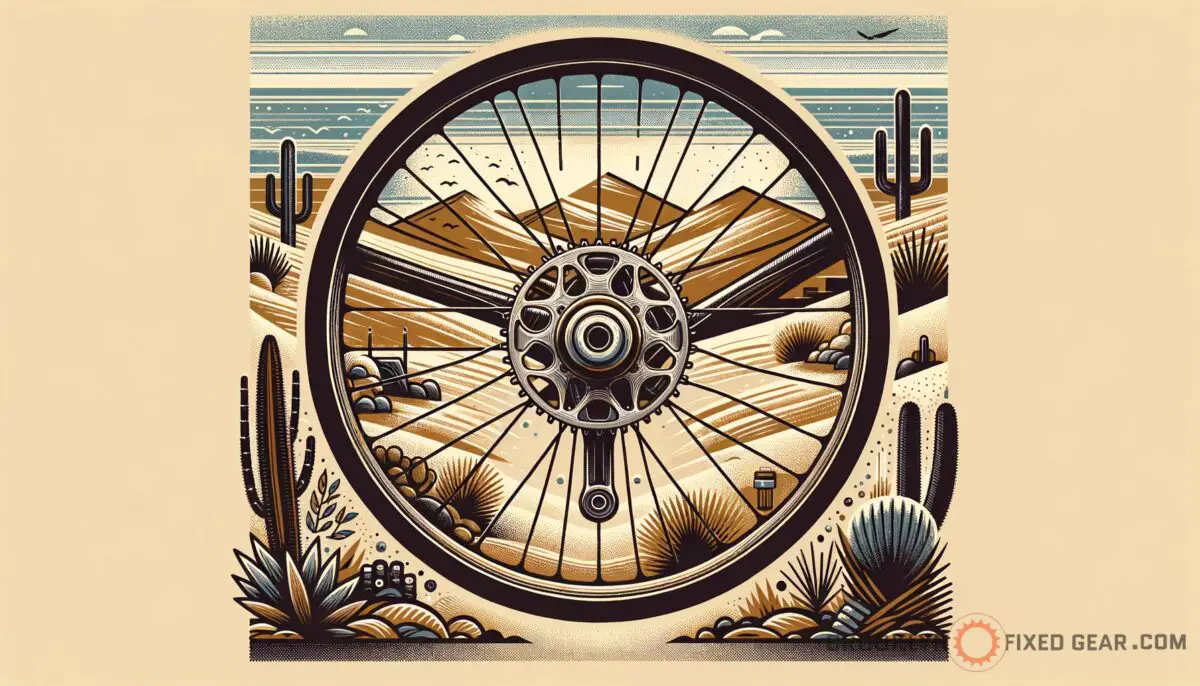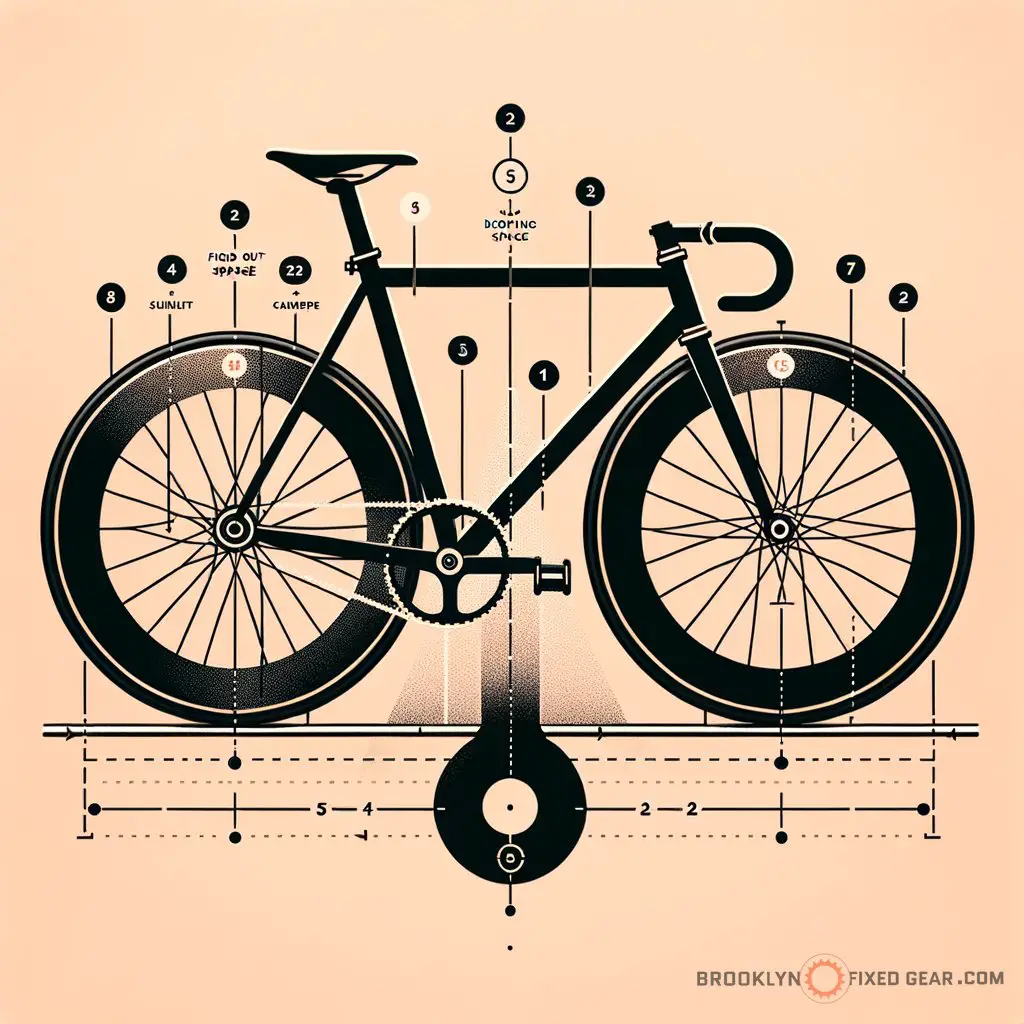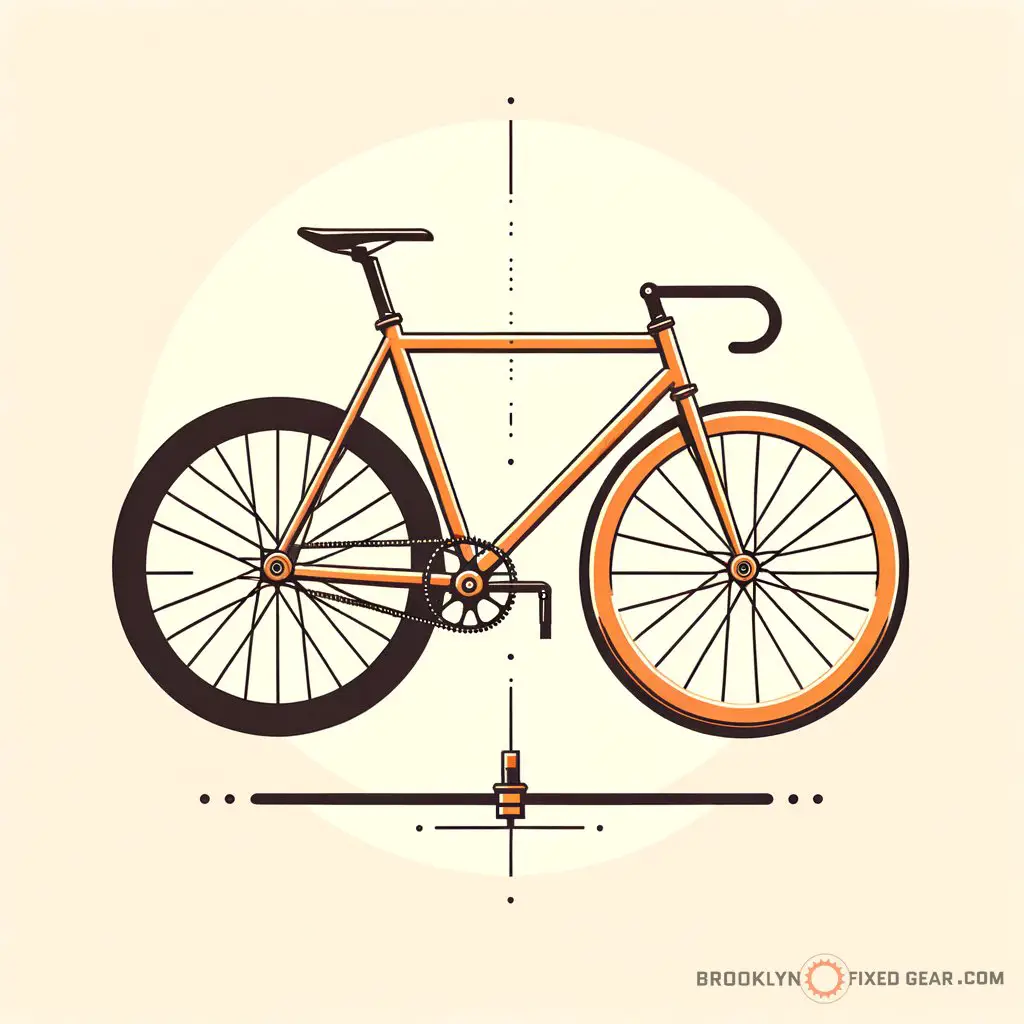Ever wondered how your fixie’s wheels align perfectly with the frame? Dive into the specifics of dropout spacing and discover why it’s a crucial aspect of your ride. You’ll walk away with a clear understanding of frame design and how it affects your fixed-gear biking experience. Curious about what makes a great fixie? Check out these top-notch fixie bikes.
Key takeaways
- Dropout spacing is crucial for aligning wheels and ensuring proper bike performance.
- Measuring and maintaining the correct spacing is critical for fixed-gear bikes.
- Compatibility with tire sizes and components depends on accurate dropout spacing.
What is dropout spacing?
Dropout spacing refers to the width between the rear dropouts on a bike frame where the wheel’s axle sits. It’s like the parking space for your rear wheel; the size matters for a proper fit. This space must match the hub length of your wheel to ensure the wheel is secured in place and your bike performs as it should.

Here’s why dropout spacing can’t be ignored:
- Ensures wheel alignment: Your bike needs balanced wheels for a smooth, straight ride.
- Affects bike compatibility: Not all wheels and frames play nice together – spacing is key.
- Impacts ride quality: Get the spacing wrong, and you’ll feel it with every pedal stroke.
Proper dropout spacing is the backbone of a stable fixie, making sure your ride’s both snug and safe. Those savvy with fixie maintenance will tell you, it’s essential for a dialed ride. Find out more on ensuring a good fit with this guide on building your fixie right.
While I’m not a bike builder by trade, I’ve had my fair share of discussions at my local bike shop on the importance of dropout spacing. People usually overlook this, focusing on components like deep V rims or flashy drop bars. But it really does have a ripple effect on your entire biking experience.
I remember this one time, a buddy of mine had to learn the hard way. He blindly grabbed a sleek wheelset online for his fixie project but didn’t consider the dropout spacing. Let’s just say he got to know his chain whip a lot more intimately after that ordeal.
It’s like that scene in “Breaking Away” where the protagonist’s love for cycling gets him into all sorts of fixes – dropout spacing included. It’s a small detail that can either make or break your cycling joyride. Check out the nuances of fixie components that can make a huge difference to your ride.
State Bicycle Co. Black Label 6061

State Bicycle Co. Black Label 6061
Importance of dropout spacing
Dropout spacing on your fixie is non-negotiable when it comes to a secure and enjoyable ride. Getting this wrong can throw off your bike’s alignment and, in turn, your performance and safety.
What dropout spacing do you need?
Every fixie or track bike has its sweet spot when it comes to dropout spacing. Typically, you’ll find road frames with 130mm spacing while track bikes come in at a tighter 120mm. Always match your frame’s spacing with your wheel hub width to avoid a world of frustration.

A mismatch can lead to wheel slippage, poor alignment, and even damage to your bike or wheels. Take a gander at the best fixie bikes around to get a feel for standard dropout spacings.
How do you measure dropout spacing?
If you’re diving into the world of custom builds or modifying your ride, you’ll need to measure that dropout spacing accurately. Here’s a simple way to do it:
- Grab some calipers and measure the inside dimensions of the dropouts where the axle sits
- Ensure the frame isn’t under any stress that could skew your measurements
Remember, precision is key, so take your time. Having the right tools can make a difference; best bike multi-tools might just have what you need.
Dropout spacing’s role in bike handling
The right fitment contributes to your fixie’s balance and dictates handling kind of a big deal when you’re zipping through busy city streets.
Effect on bike’s geometry
Dropout spacing can subtly influence your bike’s geometry. It affects the chain tension and overall wheelbase, which dictates how your bike handles. Not to mention, the spacing plays a part in tire clearance – crucial for avoiding annoying rubs or, worse, a tire that doesn’t fit.
Stay in the loop, and you won’t find yourself pedaling a frame that makes you work harder than you need to. Give drop bars a shot if you’re looking to switch up your handling game.
Tuning for performance
If you’re tweaking your fixie for performance events or just want a smoother ride, dropout spacing should be part of your checklist. The right setup means your wheel isn’t shifting mid-sprint, and your drivetrain runs as smooth as butter.
Get your bike dialed in for the win, and pay close attention to every component’s fitment, from your drivetrain to your wheelset. To learn more about getting your bike performance-ready, explore what ‘dialing in’ means in the context of cycling.
Dropout spacing and maintenance
Regular bike checks are vital, and yes, dropout spacing is on that list too. It’s about ensuring everything holds up over time.
Why regular checks are essential
Like any part of your bike, wear and tear happen. Frames can bend, and dropouts can warp. Regular checks will catch any changes in spacing before they become problems.
Don’t let maintenance slide or you might face some serious hurdles down the line. Better safe than sorry, right? In case you’re looking for some pro tips on maintenance, here’s a multi-tool that could make your life easier.
Tips for maintaining dropout spacing
- Inspect the dropouts regularly for signs of wear or distortion
- If you’ve got a steel frame, a skilled bike mechanic might be able to adjust spacing issues, but it’s a delicate procedure
Keep your bike in top-notch condition by giving it the TLC it deserves. And, of course, always ensure you have the right tools for the job.
Dropout spacing variations

Fixed-gear and track bikes
Traditionally, these two-wheeled speedsters sport a 120mm spacing, keeping it tight and efficient for that responsive ride we love so much.
Road and mountain bikes
They sit with wider rear dropout spacings, usually 130mm and 135mm, respectively, accommodating different gearing systems like derailleurs.
Understanding these nuances means you can chat specs with any fellow fixed-gear enthusiast or bike builder. Now that you’ve got the lowdown on dropout spacing, you’re set to tackle the city streets with confidence.
Summary: This table provides standard dropout spacing measurements for different types of bicycles, highlighting how they affect the bike’s compatibility and performance.
| Bike Type | Standard Spacing (mm) | Compatibility | Performance Impact |
|---|---|---|---|
| Fixed-gear | 120 | Wheel hub width must match | Essential for wheel alignment |
| Track | 120 | Specific to track cycling standards | Affects responsiveness and handling |
| Road | 130 | Wider for various gearing systems | Stability at higher speeds |
| Mountain | 135+ | Allows for larger tires and gears | Strength and shock absorption for off-road |
Fixed-gear cycling is an art that involves a keen understanding of your bike and how to get the most out of it. With fewer parts than a road bike, fixies are simpler to maintain and give you better control, especially when cycling through busy city streets.
Spacing measurements ensure your bike operates smoothly and maintains durability under the stress of regular use.
Bike type, compatibility, and performance impact – a quick guide to dropout spacing standards.
More cycling tips
Cycling’s not just about getting from point A to B; it’s an art that involves a keen understanding of your bike and how to get the most out of it. Here are a few extra tips to elevate your cycling experience, especially for my fellow fixed-gear enthusiasts.
- Invest in a high-quality chain whip to make drivetrain maintenance a breeze.
- Always carry a multi-tool designed for bikes during rides for unexpected repairs.
- Read up on how to choose a bike saddle that fits you perfectly for those long rides.
- Learn the ins and outs of your bike’s drivetrain to optimize performance.
- Stay ahead of the trends by understanding what deep V rims can do for your fixed-gear bike.
- If track cycling is your jam, learn the technique of drafting to conserve energy and improve your times.
When looking after your fixed-gear or single-speed bicycle, it helps to follow some dos and don’ts to ensure a smooth ride and prolonged bike life.
Dos and don’ts of bike maintenance
| Do | Don’t |
|---|---|
| Check your tire pressure regularly | Ignore strange noises or wobbles |
| Keep your drivetrain clean and lubricated | Skip regular inspection of brakes and wheels |
| Make sure your wheels are properly aligned | Ride with a misaligned handlebar or saddle |
| Regularly check the tightness of your bolts | Forget to inspect your bike for rust or damage |
Regular upkeep is key to enjoying a hassle-free fixie life on the streets.
Maintenance essentials: Keep your ride smooth and your repair list short.
Advantages and disadvantages of fixed-gear cycling
Choosing to ride a fixed-gear bike comes with its unique set of benefits and drawbacks. Here’s a rundown to help you weigh your options.
Advantages
- Simple maintenance: With fewer parts than a road bike, fixies are easier to care for.
- Better control: Hard-wired to your motion, you get better feedback from the bike.
- Great for training: It strengthens leg muscles due to constant pedaling.
- Affordable: Generally, fixies are cheaper than their multi-geared counterparts.
- Aesthetics: Sleek, minimalistic design that’s timeless and customizable.
Disadvantages
- Challenging for beginners: There’s a learning curve, especially with braking using leg power.
- Not versatile: Struggles on various terrains, unlike road or mountain bikes.
- Limited speed: You’re confined to one gear, which limits top speed and efficiency on hills.
- No coasting: The inability to freewheel means always having to pedal, which can be taxing.
If you are a visual learner, check out this video titled ‘Measuring Dropout Spacing – Valencia Cycles Build’
Frequently asked questions (FAQ)
How does dropout spacing affect tire size compatibility?
Dropout spacing can directly impact the size of tire you can use on your bike. Wider spacing usually allows for wider tires, which means if you have a frame designed for narrow spacing, you’ll be limited in how wide you can go without rubbing against the frame or brakes. Always check the specs on your frame and match them with your tire choice to avoid any mishaps.
Can dropout spacing be adjusted if I have the wrong size?
Adjusting dropout spacing is possible, but it’s a job best left to professionals, especially if your frame is made of metal like steel. In some cases, a bike mechanic can spread or narrow the dropouts to fit a new wheel size, but it’s crucial this is done carefully to maintain the integrity and safety of the frame.
Is there a universal dropout spacing standard for all bikes?
No, there’s no universal dropout spacing standard because different types of bikes are designed for different purposes. You’ll find track bikes with narrow spacing of around 120mm, road bikes typically at 130mm, and mountain bikes usually at 135mm or more to accommodate various components and riding styles. Always consult your bike’s specifications for the correct measurements.
Final thoughts
As you can see, dropout spacing is more than just a technical spec; it’s essential to the integrity of your cycling experience. Understanding its role can greatly enhance the performance and longevity of your bike, ensuring you enjoy every ride to the fullest. So, next time you’re tweaking or upgrading your bike, give dropout spacing the attention it deserves.
Do you have any questions or experiences related to dropout spacing that you’d like to share? Did I cover everything you wanted to know? Let me know in the comments section below I read and reply to every comment. If you found this article helpful, share it with a friend, and check out my full blog for more tips and tricks on cycling. Thanks for reading, and ride on!















